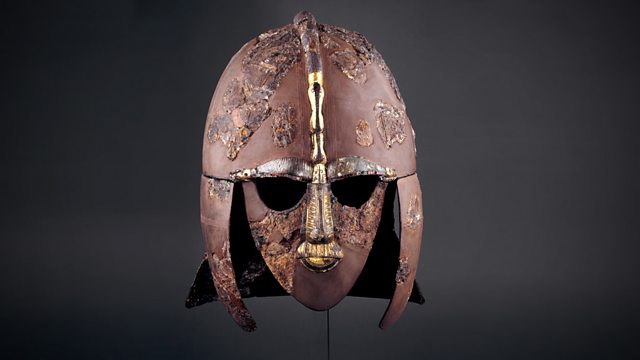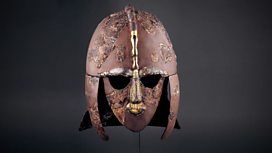Sutton Hoo helmet
Neil MacGregor's history of the world as told through objects arrives in 7th Century Suffolk. He describes the period through the famous Anglo-Saxon helmet from Sutton Hoo.
The history of the world as told through one hundred objects. This week Neil MacGregor, the director of the British Museum, is exploring the world in the 7th Century, at a time when the teachings of Islam were transforming the Middle East and goods and ideas were flowing both ways along the tangle of connections that have become known as the Silk Road.
But what was happening in Britain at this time? In today's programme, Neil travels to East Anglia to describe the sensational burial discovery that has been hailed as a "British Tutankhamen". He tells the story of the Sutton Hoo helmet, the world it inhabited and the imagination it has inspired. The poet Seamus Heaney reflects on the helmet in the context of the great Anglo-Saxon epic poem, Beowulf, and the archaeologist Angus Wainwright describes the discovery of the great grave ship where the helmet was found.
Producer: Rebecca Stratford
Last on
![]()
Discover more programmes from A History of the World in 100 Objects about death and ritual
About this object
���dz����پ��Dz�:�� Suffolk, England
Culture: Saxons and Vikings
Period: 7th century AD
Material: Gold and Metal
��
The Sutton Hoo Helmet is one of the most important Anglo Saxon finds of all time. It was buried in the grave of a warrior chieftain. Alongside it were a vast array of weaponry and a 27-metre-long ship. Although the helmet belonged to a powerful war-leader we cannot be certain who was buried at Sutton Hoo. When it was found it conjured up images of the warrior culture of the great Anglo Saxon epic poem, Beowulf that was written at a similar period.
What does Sutton Hoo tell us about the Anglo Saxon world?
The discovery of the Sutton Hoo burial in 1939 profoundly changed opinions of an era long dismissed as the dark ages. This was a period when some of the North Sea states - England, France, Norway, Denmark and Sweden were first coming into existence. The tomb contained hanging bowls from the Celtic West, gold coins from mainland Europe and silver tableware from the eastern Mediterranean. The Anglo Saxon world was connected through a complex trade network and gifts were often exchanged among the highest tiers of society.
Did you know?
- Over 4000 garnets, red precious stones, were used on objects from Sutton Hoo, some of them in the helmet's eyebrows.
The face of the Anglo-Saxons
By Sonja Marzinzik, curator, British Museum
��
I think it’s fair to say that the Sutton Hoo helmet is the face of the Anglo-Saxons, perhaps even all of the early middle ages in Europe. It is shown on numerous book covers, got its own commemorative stamp for the 250th anniversary of the British Museum and features in countless documentaries on the period.
My favourite reinterpretation is found on a Swedish brand of pickled herrings. An image of the Sutton Hoo helmet has been modified to give a gentle smile, presumably in anticipation of the delicacies inside.
The big question has always been how the Sutton Hoo helmet relates to other helmets from this time found in Scandinavia. Having seen a number of them in the flesh, I am convinced that whoever made the Anglo-Saxon helmet must have known the Swedish example. Although each helmet is an individual piece, they all have commonalities that unite them as a group. In addition, there’s the presence of the same motifs on the repoussé panels, for example the spear dancers and the fallen warrior, and the similarity of wire-inlaid eyebrows and animal heads cannot be a coincidence.
Whether this was because the Sutton Hoo helmet came from Scandinavia, whether it was made by a Swedish craftsman travelling to East Anglia, or by an Anglo-Saxon craftsman who had travelled eastwards is a riddle still to be resolved.
More than a face-guard
By Martin Carver, Professor Emeritus, Department of Archaeology, University of York
��
The helmet is the armoured head of a warrior, attended by gods. Made of hammered iron, proof against spear, sword and axe, it is also covered with protective metaphors.
Across the face is a bird with splayed wings, its body forming the warrior’s nose, the tail his moustache and the wings his eyebrows. The bird soaring up meets the jaws of a dragon plunging down, its thick iron body inlaid with zigzag silver wire curving over the crest.
The man’s head is equipped with defence at every angle, like a battle ship: the wingtips finish in wild-boar jaws, guarding the lateral blind spots; the dragon has a snarling mouth at its tail, bringing up the rear. All the heads, even the bird’s, have sets of sharp fangs: the bared teeth of the animal bodyguard.
On the top of the crest is a little hole to carry a plume, and the sides of the helmet carried small panels commemorating victories – an enemy ridden down by a horseman, triumphant warriors dancing. Dragon and bird each have two gleaming eyes of red polished garnet, extra vision for the warrior’s own eyes, watching within their hollows, menacing as dark glasses.
Dragon, wild boar, bird of prey – these are the symbolic animals of Anglo-Saxon East Anglia where the helmet was found – part of an immense treasure buried with a political leader in a chamber, in a ship, in the early seventh century AD. Helmet and ship-burial were elements of a language of belief then shared widely among the peoples of the Northern Seas. In partnership with their animal gods, men win battles, hoard wealth, claim land. Ruthless, brave, enduring, these people built the kingdoms that northern Europe still has.
The Sutton Hoo helmet is more than a face-guard – it is a poem, a political manifesto in silver and iron.��
Transcript
Broadcasts
- Tue 8 Jun 2010 09:45�������� Radio 4 FM
- Tue 8 Jun 2010 19:45�������� Radio 4
- Wed 9 Jun 2010 00:30�������� Radio 4
- Tue 16 Mar 2021 13:45�������� Radio 4
Featured in...
![]()
Leaders and Government—A History of the World in 100 Objects
More programmes from A History of the World in 100 Objects related to leaders & government
![]()
Death—A History of the World in 100 Objects
More programmes from A History of the World which relate to the ritual of death.
Podcast
-
![]()
A History of the World in 100 Objects
Director of the British Museum, Neil MacGregor, retells humanity's history through objects






